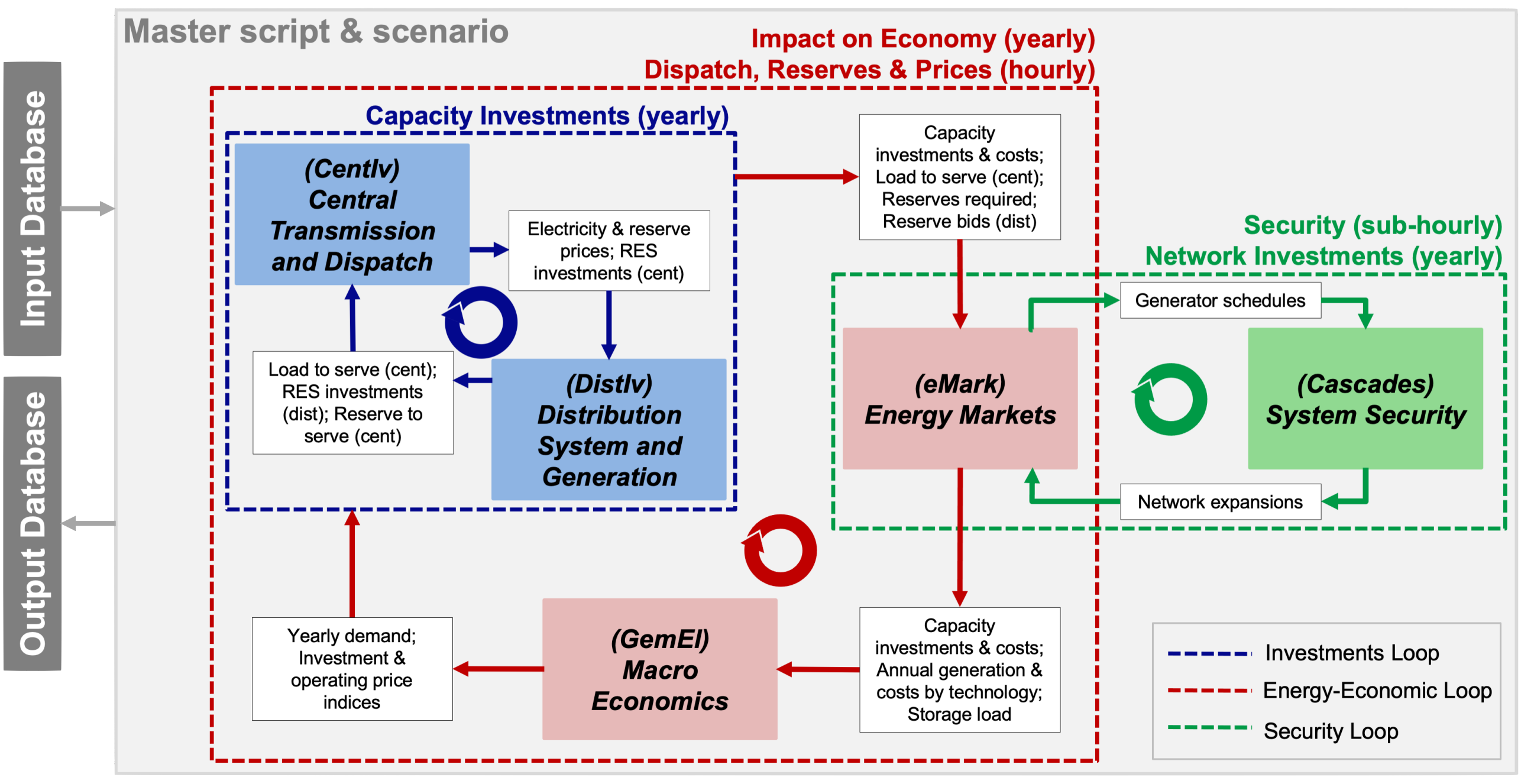Electricity Markets Module (eMark) - part of the Nexus-e platform
- The Nexus-e modeling platform is a modular combination of interconnected energy and economic models serving as an interdisciplinary framework for developing pathways for the future energy system and analyzing the impact of technological, economic, regulatory, and societal developments.
- As part of the Nexus-e platform, the Electricity Market Module (eMark) determines all generator schedules and commodity prices using a market-based clearing that mimics the market structures, sequential timing, and intra-zonal trading limits.

Overview of the Nexus-e platform including the five modules (colored boxes), the three ’loops’ (colored arrows), and the interfaces (white boxes).
- Transitioning energy systems impact all sectors of the economy and therefore require more holistic models of the energy-economic system including combining top-down and bottom-up approaches.
- Traditional electricity dispatch models used to determine generator production schedules tend to use assumptions that do not reflect the currently employed market process (such as transfer limits between zones or separated energy and reserve clearings). The eMark module was created to better reflect the existing market clearing processes and also be able to simulate possible future enhanced versions of these processes.
- The Nexus-e platform combines five core modules through well-defined interfaces to represent a much broader scope of the energy-economic system than stand-alone modeling approaches. The five modules, which can communicate with each other through well-defined and automated interfaces within three loops (i.e., Investments loop, Energy-Economic loop, and Security loop), are:
- General Equilibrium Module for Electricity (GemEl),
- Centralized Investments Module (CentIv),
- Distributed Investments Module (DistIv),
- Electricity Market Module (eMark),
- Network Security and Expansion Module (Cascades).
- The purpose of the eMark module is to simulate a market-based clearing (i.e., auction) of supply offers and demand bids for both electricity and reserves. This module mimics the current sequential structures and timing employed in the simulated regions to clear all electricity market products. eMark has the critical role in the Nexus-e framework to provide a market-based perspective and enable assessments of future market structures.
- eMark applies constraints for intra-zonal trading that reflect the current market coupling mechanisms (i.e., available transfer capacity (ATC)-based or flow-based (FB) limits). Additionally, eMark can represent mixed configurations of ATC and FB connected market zones (such as what exists in Europe today).
- eMark provides high temporal (hourly) resolution and spatial (zonal) resolution equivalent to those of the existing market processes.
- The eMark module simulates the energy and reserve market clearing over a one year period using an hourly resolution. In three sequential steps, the model simulates the clearing of the future market, balancing market, and day-ahead market.
- eMark is a linear optimization coded in external page Matlab utilizing the external page MatPower package and solves using the Gurobi optimization solver.
- eMark utilizes the automatic external page network reduction process developed by FEN to a reduced zonal representation from any given simulated nodal transmission network.
external page Final reports of the project and a summary of the results
An external page interactive visualisation tool for the modelling results
Latest news:
- Jan. 2021: BFE Energiaplus: external page Die Energiezukunft modellieren: Wie sich Nexus-e und die Energieperspektiven 2050+ ergänzen
- Jan. 2021: The ETH recently featured the Nexus-e modeling platform on the ETH homepage
- Jan. 2021: Nexus-e was highlighted by an external page article written in energate (German)
- Dec. 2020: Nexus-e researchers contributed to the ETH Energy Blog with an article about the lack of use of computational models in public policy making
- Sep. 2020: Nexus-e contributed a external page topic and participated in the Energy Data Hackdays 2020 in Brugg
- Sep. 2020: The Nexus-e platform was highlighted in this past years ETH Industry Week [external page Video]

Phase 1: platform development
Goal: investigate the Swiss nuclear phase-out and the role of flexibility providers
Partners: ETHZ, BFE, Swissgrid, Ernst-Basler and Partner (EBP)
Duration: 09/2016 – 02/2021
Funding: BFE
CH2040
Goal: investigate net-zero scenarios and the impacts of moving toward autarky for Switzerland
Partners: ETHZ – Nexus-e, ETHZ – Calliope (Prof. Anthony Patt)
Duration: 11/2020 – 11/2021
Funding: Individual donor
Team:
Project Leader:
- Prof. Gabriela Hug (ETHZ-PSL)
Principal Investigators:
- Prof. Gabriela Hug (ETHZ-PSL)
- Dr. Turhan Demiray (ETHZ-FEN)
- Prof. Giovanni Sansavini (ETHZ-RRE)
- Prof. Massimo Filippini (ETHZ-EEPE)
- Dr. Christian Schaffner (ETHZ-ESC)
Researchers:
- Dr. Jared Garrison (ETHZ-FEN)
- Dr. Blazhe Gjorgiev (ETHZ-RRE)
- Xuejiao Han (ETHZ-PSL)
- Dr. Florian Landis (ETHZ-EEPE)
- Elena Raycheva (ETHZ-PSL)
Project Management & Software:
- Dr. Marius Schwarz (ETHZ-ESC)
- Xuqian Yan (ETHZ-ESC)